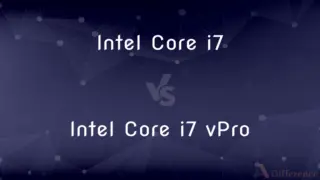Monocot Embryo vs. Dicot Embryo — What's the Difference?
By Tayyaba Rehman — Published on December 21, 2023
Monocot embryos have one cotyledon, while dicot embryos have two cotyledons.

Difference Between Monocot Embryo and Dicot Embryo
Table of Contents
ADVERTISEMENT
Key Differences
Monocot Embryo and Dicot Embryo represent two primary classes of angiosperm embryos. While a monocot embryo develops with a single cotyledon (leaf-like structure), a dicot embryo typically bears two of these structures.
Originating from the seed's embryonic plant, both the Monocot Embryo and the Dicot Embryo play vital roles in germination and early plant development. However, they have structural distinctions, with the monocot's single cotyledon contrasting the dicot's dual cotyledons.
Monocot Embryos typically give rise to plants with leaves that bear parallel veins, such as grasses and lilies. In contrast, Dicot Embryos are precursors to plants with broad leaves that exhibit a branching vein pattern, like beans and sunflowers.
When discussing the initial roots of plants, Monocot Embryos usually develop fibrous root systems, whereas Dicot Embryos often form a primary taproot from which secondary roots sprout.
The classification between Monocot Embryo and Dicot Embryo isn't just academic. It has practical implications in agriculture, botany, and plant breeding, affecting everything from plant behavior to their responses to the environment.
ADVERTISEMENT
Comparison Chart
Number of Cotyledons
One
Two
Leaf Vein Pattern
Parallel
Branched
Root System
Fibrous
Taproot
Floral Parts
Typically in multiples of three
Usually in multiples of four or five
Examples
Grasses, lilies
Beans, sunflowers
Compare with Definitions
Monocot Embryo
An embryo type seen in plants with floral parts often in threes.
Orchids, with flowers in parts of three, have a monocot embryo.
Dicot Embryo
Embryo type in plants with floral parts in fours or fives.
Roses, with their floral parts typically in fives, develop from a dicot embryo.
Monocot Embryo
The precursor to plants with fibrous root systems.
Corn plants, which have a fibrous root structure, stem from a monocot embryo.
Dicot Embryo
Seed embryo leading to plants with branching leaf veins.
Oak trees, with their branching veined leaves, stem from a dicot embryo.
Monocot Embryo
Seed embryo that gives rise to plants with parallel-veined leaves.
Lilies, originating from a monocot embryo, have leaves with parallel veins.
Dicot Embryo
Double-cotyledon bearing seed embryo.
The twin cotyledons in sunflower seeds are a feature of the dicot embryo.
Monocot Embryo
An angiosperm embryo with one cotyledon.
Grasses develop from a monocot embryo.
Dicot Embryo
An angiosperm embryo with two cotyledons.
Bean plants originate from a dicot embryo.
Monocot Embryo
Single-cotyledon bearing seed embryo.
The single cotyledon of the rice grain is a characteristic of the monocot embryo.
Dicot Embryo
Precursor to plants that often develop a taproot system.
Carrots, having a pronounced taproot, emerge from a dicot embryo.
Common Curiosities
Can you give an example of a plant originating from a Monocot Embryo?
Yes, grasses like wheat and rice develop from monocot embryos.
What is a Monocot Embryo?
A monocot embryo is an angiosperm embryo with one cotyledon.
And Dicot Embryos?
Dicot embryos usually result in plants that develop a taproot system.
How does a Dicot Embryo differ from a Monocot Embryo?
A dicot embryo has two cotyledons, while a monocot embryo has only one.
Is it possible for a plant to be neither monocot nor dicot?
While most angiosperms fall into these categories, there are a few exceptions and non-angiosperm plants.
Are monocots or dicots more common?
Both groups are widespread, but there are more species of dicots than monocots.
Which plants typically stem from a Dicot Embryo?
Plants like beans, sunflowers, and tomatoes originate from dicot embryos.
How does leaf vein pattern differ between Monocot and Dicot Embryos?
Monocot embryos give rise to plants with parallel leaf veins, while dicot embryos lead to plants with branching veins.
How can one visually distinguish between Monocot and Dicot plants?
One common way is to observe the number of cotyledons in the seed or the pattern of leaf veins.
Are floral parts a distinguishing feature between Monocot and Dicot Embryos?
Yes, monocot embryos produce plants with floral parts often in multiples of three, while dicot embryos give rise to plants with floral parts in fours or fives.
How are Monocot and Dicot Embryos essential for botanists?
These classifications help botanists understand plant evolution, behavior, and response to the environment.
Can the classification between Monocot and Dicot Embryos impact agriculture?
Yes, understanding the difference can affect planting strategies, breeding, and crop management.
What type of root system is associated with Monocot Embryos?
Monocot embryos typically produce plants with fibrous root systems.
Does the classification impact plant breeding?
Yes, knowing whether plants are monocots or dicots can influence breeding techniques and hybridization strategies.
Why is it crucial to know the difference in practical terms?
Knowledge of whether a plant is a monocot or dicot can influence cultivation practices, pest management, and harvesting techniques.
Share Your Discovery

Previous Comparison
Primordial Follicle vs. Primary Follicle
Next Comparison
Tennis Shoes vs. Running ShoesAuthor Spotlight
Written by
Tayyaba RehmanTayyaba Rehman is a distinguished writer, currently serving as a primary contributor to askdifference.com. As a researcher in semantics and etymology, Tayyaba's passion for the complexity of languages and their distinctions has found a perfect home on the platform. Tayyaba delves into the intricacies of language, distinguishing between commonly confused words and phrases, thereby providing clarity for readers worldwide.
















































